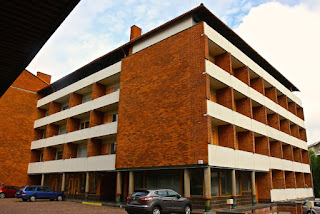today I would like to present two new Aalto sites located in Finland's capital region. Both are large scale housing areas and therefore I thought it makes sense to present them in a joint post. The first housing area I am going to present is the Harjuviita Apartement Houses located in Espoo.
Site No. 80: Harjuviita Apartment Houses in Espoo (1962-64)
 |
| Keilaniemi metro station |
The housing area was part of the 1950s prototype of a garden city in the district of Tapiola. The idea of the Tapiola Garden City was to bring housing and nature closer together. Various architects were invited to present solutions, one of them was Alvar Aalto. Although Aalto didn't like the idea of building high-rise apartment buildings he also understood the need of them in areas where building land is limited. Nevertheless, Aalto put a lot of effort to integrate the buildings as good as possible into the natural surroundings. He also tried to offer the residents spacious dwellings and an ideal orientation of the buildings to allow for more natural light in the apartments.
The Harjuviita Apartment Houses share many common elements with Aalto's other high-rise buildings such as the Hansaviertel Residential Buildings in Berlin or the Schönbühl Apartment House in Lucerne. Especially the fan-shapes and the deep atrium-like balconies show certainly familiar elements.
As this is a residential area, the buildings are only viewable from outside. However, as they are only one metro stop from the Aalto University away, they are certainly worth a visit if you are already in the area and have some time to spare.
Site No. 81: Housing for the National Pension Institute in Helsinki (1952-54)
About a decade before the erection of the Tapiola Garden City, Aalto was commissioned to design another housing area in the capital region of Finland. This housing area was meant for the workers of the national pension institute (KELA) whose headquarters Aalto designed in downtown Helsinki at about the same time. The housing area, located in the district of Munkkiniemi, is only a stone throw away from the Aalto House, which was Aalto's home in Helsinki for many decades.
While the Harjuviita Apartment Houses were already kept in white brick, signs of Aalto's transition to his white period, the National Pension Institute's housing area is still part of Aalto's earlier red brick phase.
The housing area consists of four volumes, each five stories high. Buildings were places following the layout of the street but with an intension of keeping a green space in the middle, like an Italian piazza. The apartments are rather kept small and ordinary, featuring, however, own balconies each.















I visited a number of Aalto buildings while on a tour of Scandinavia with my architecture school class. They made a profound impression. Sometimes dramatic but never showy. Extremely personal, but never capricious. Warm, humane, full of delightful details. Always with something to say, but never pedantic. Full of lessons for a lifetime. Thanks for making the lesser known works more accessible.
ReplyDeleteThank you very much Nat for your comments and reflections on Alvar Aalto's work, well said!
ReplyDelete